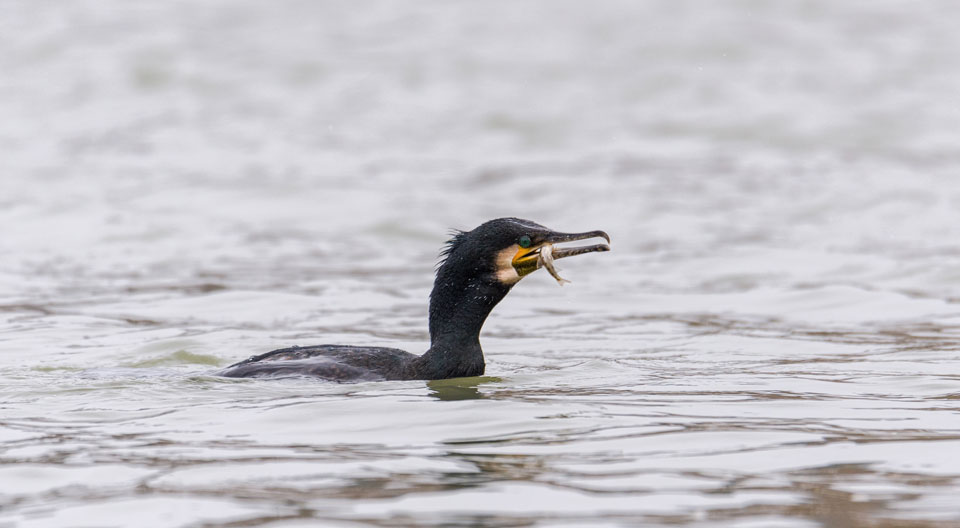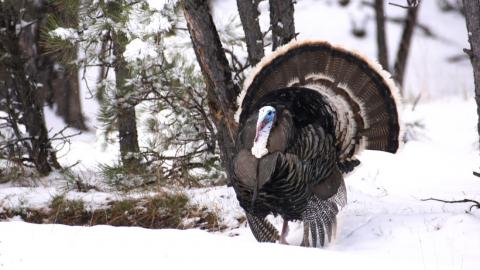Don C. Keller | Originally published in GameKeepers: Farming for Wildlife Magazine

How Cormorants Affect Fishing
Last winter, my wife and I were driving north of Montgomery, Alabama, close to the Alabama River, when she looked out the window and commented, “Look at that large flock of geese!” “Geese? Those aren’t geese,” I said. “Those are ‘fish terrorists,’ better known as cormorants or water turkeys.” To make matters worse, they are federally protected terrorists. Unlike the occasional terror attacks we see on the news, these flocks of terror descend on unsuspecting lakes every day all across the United States.
The double-crested cormorant (Phalacrocorax auritus) is a large, migratory fish-eating bird whose numbers have exploded in the last 15 years. This population increase can be attributed to the ban on DDT, reduction in wetlands and protection under the Migratory Bird Treaty Act. In large numbers, cormorants are a menace to any body of water that has a fish population.
On large lakes like Lake Texoma on the border of Oklahoma and Texas, it is common to see a flock of water turkeys hundreds of yards long. Bill Carey is a longtime fisherman and owner of Striper Express on the Texas side of Lake Texoma. According to Bill, “I have been running charters on this lake for over 40 years. I have never seen water turkey flocks so large. You would like to think it’s just one large flock, but my guides see large flocks of water turkeys all over the lake.” Lake Texoma, like other lakes, depends on an abundant supply of bait fish to support bass, bluegill and other fish. It is difficult to sustain a healthy supply of baitfish that has so many predators chasing them.
Cormorants are not wading birds like great blue herons, but are swimmers that can dive and swim for long distances underwater to catch their prey. They are so efficient that centuries ago the Chinese figured out that they could use cormorants for fishing. They would capture a cormorant, tie a long string around one of its legs and place a collar around the bird’s throat. They would then go out in a boat, hold the string while the bird dove down and swallowed a fish. They would then pull the bird back to the boat and squeeze the neck above the collar and plop the fish into the boat.
Large flocks of cormorants, sometimes numbering more than a thousand, can descend on lakes, rivers or fish farms with devastating results. Studies have confirmed that these birds can eat one to one-and-a-half pounds of fish per bird per day. Not unlike a swarm of locusts landing on a wheat field, large flocks of cormorants can destroy a fish farm in a matter of days.
Mike Freeze is the owner of Keo Fish Farm, a 1,500-acre hybrid striped bass and triploid grass carp farm located in central Arkansas. Mike has a master’s degree in Fisheries and Wildlife and has served as a Commissioner of the Arkansas Game and Fish Commission. I recently spoke with Mike and asked him what kind of impact these birds have on his aquaculture operation.
Top fish is a nine-inch grass carp that was swallowed by a cormorant.
Bottom fish is a 12-inch gizzard shad that was too big to swallow but
shows a cormorant wound.

Bottom fish is a 12 inch gizzard shad that was too big to swallow but
shows a cormorant wound.
“Don, from October through May of each year, we are under siege from the air. I must dedicate at least two employees full-time and many more on a part-time basis to try and scare away the wave after wave of cormorants that descend upon us. Notice I said scare, because it is physically impossible to impact their actual numbers. Our only hope is to kill a few, thereby reinforcing their fear of man and moving them to some unsuspecting neighbor’s farm for a short while. Besides the cost of men, vehicles, fuel, etc., expended in this effort, our purchases of ammunition alone sometimes exceed $10,000 in a year. This is a massive defense effort. Yet, each year, we lose somewhere between $100,000 and $200,000 of marketable fish to this bird from hell! In addition to these losses, I have harvested ponds of fish where every single fish left in the pond had been injured by cormorants,” Freeze said.
To assist fish farmers, the U.S. Department of Agriculture has issued a Cormorant Depredation Order which is in effect for 13 states. This order allows for the controlled harvesting (shooting) of cormorants that pose an immediate threat to a farmer’s livelihood. For the private landowner, the best tactic is to harass the birds until they leave and go to another lake. This can be done by using fireworks or special noisemakers called “bird bangers.” These can be purchased from the Reed-Joseph Company in Greenville, Mississippi. If all else fails, landowners can contact the USDA’s Wildlife Services and request a permit to shoot the birds.
How much damage can cormorants do to a fish population? One study in New York showed that a large population of cormorants was devastating the game fish population, including the smallmouth bass fishery on Lake Ontario. The study found that the cormorants were consuming 1.3 million bass per year. Most of this 1.3 million were smallmouth that were three to five years old. As cormorants populate, larger flocks appear year after year. At this rate, a small bass fishery could be devastated in just a couple of years.
A couple of years ago, I spoke about bird damage with the late Jack Dunn of Dunn’s Fish Farm in Arkansas. Jack said that the year before, he had let his employees off from the first of December until after the new year since this was a slow time for fish sales and the weather was very cold. He noticed the flocks of cormorants but did not feel overly concerned. When he started to harvest bass the following spring, he realized that he had lost approximately $500,000 worth of fish to the birds in less than 30 days.
I recently spoke with Jerry Feist in Alabama, who is with the USDA’s Wildlife Services. Jerry said that based on their counts there are at least 25,000 birds that stay in the catfish farming area of west Alabama, and 65,000 that stay in the fish farming area of Mississippi. This does not include the cormorants that are on the public waterways in the rest of these states.
Do the math. One hundred thousand birds in Mississippi eat one pound of fish per day x 90 days = 9,000,000 pounds of fish lost. Whether cormorants are eating forage fish or sport fish, it has a negative effect on the fish population, which results in poor angler harvest. This damage may not be realized for several years since much of the forage and sport fish lost are juvenile fish. As older mature fish decrease in numbers, there are fewer fish left to mature and fewer baitfish for them to survive on.
Worse yet, many of these birds are beginning to nest here in the South rather than migrating back to their traditional breeding sites in the North. Mr. Feist said they know of at least six nesting sites on Lake Guntersville alone. At the nesting and roosting sites, cormorants have such a high amount of fecal droppings that it kills vegetation. In areas where they consistently roost, almost all of the trees will be killed due to the droppings. It is only natural to ask that if cormorants are nesting year-round in the same area, should they still be protected under the Migratory Bird Treaty Act? More studies are needed, but it is a legitimate question.
Cormorant with its wings spread for drying after it had been diving for fish.

Think about this. If you go fishing without a license or catch one bass over the limit, you can be arrested. But if 1,000 cormorants move in, they are protected by the U.S. Fish and Wildlife Service. It will take a coordinated effort across federal, state and local agencies to mitigate this problem. We can all agree that water turkeys should be protected, but they should also be managed. The ecological and monetary damages are compounding daily so, hopefully, this cooperation will happen sooner rather than later.
In summary, there are only a few things the private landowner can do to protect his fish population from this villain from the sky. First, observe your lake every week from November through March to see if any cormorants appear. Then, take whatever steps are necessary to move them to another location. Before you take action, ensure that you have checked all federal, state and local regulations. One misstep, and you could be committing a felony. With that said, do whatever you can legally do to relocate the water turkeys. Otherwise, the fish terrorists will take over, and there is little you can do after they leave but restock.
Don C. Keller is a Certified Fisheries Scientist and co-owner of American Sport Fish.































